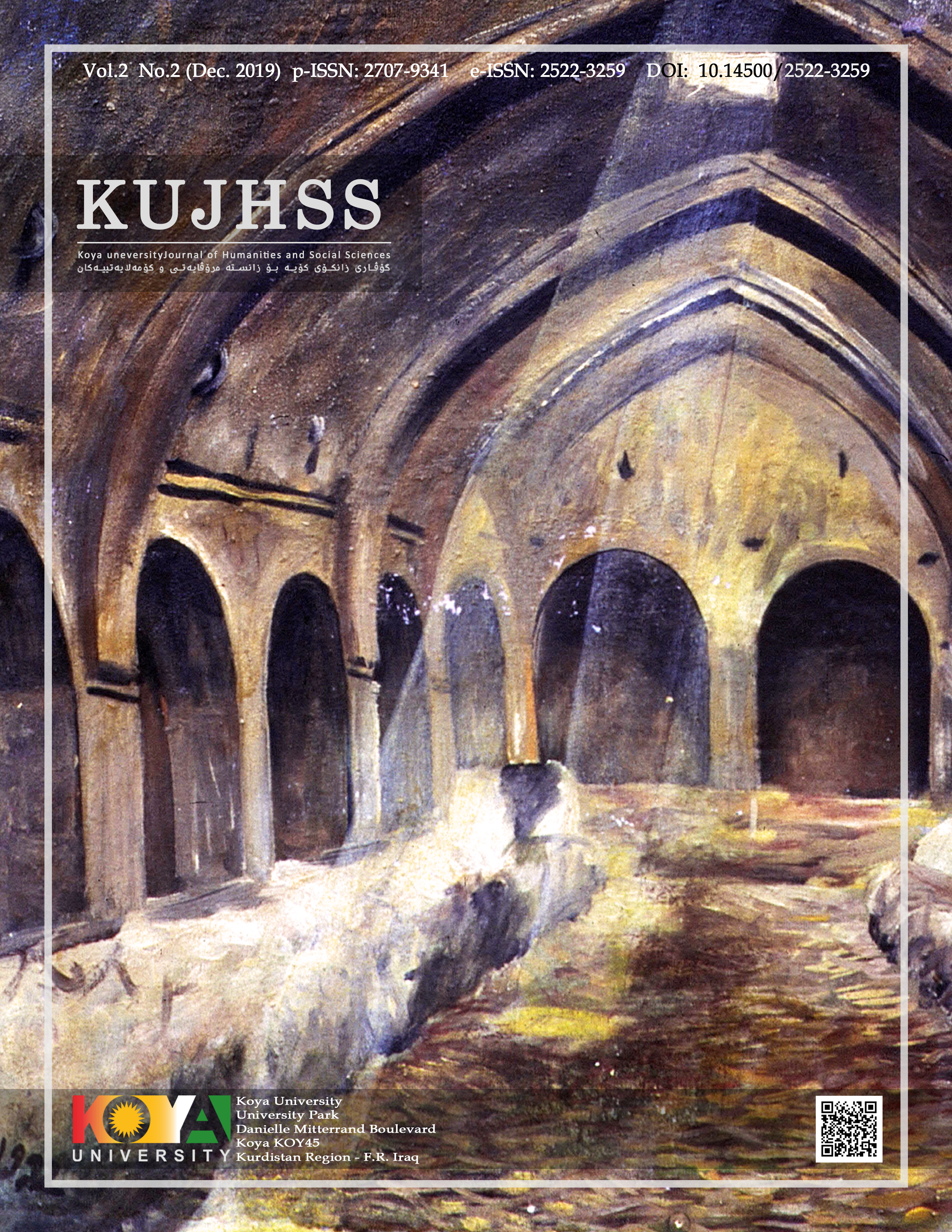Factors and Purposes of Appointing Sexual Scenes in Kurdish Novels
DOI:
https://doi.org/10.14500/kujhss.v2n2y2019.pp22-31Keywords:
Aim, Erotica, Factor, Motive, TermAbstract
There is no doubt that sex is the first and final mean for all the creatures to give birth of more generations and to continue in life. Apart from that, it is also an important factor in being pleased and comfortable. In other words, in the absence of sex, there will be the appearance of a complicated situation in the life of human beings. There is also no doubt that literature also is the mirror of the society and reflects the reality in all its positive and negative aspects, its beauty and ugliness, it's allowable and taboos. Therefore, we see that the process and sex relation has been studied and considered in all nations’ verbal and written literature and each according to its tradition and features. Like other literatures, Kurdish verbal and written literature has remarkable participation in this purview especially in novel but in critical studies the scenes which have appointed erotic scenes have been studied less. In our point of view, we think that this is due to a kind of shyness, fear or social obstacles. Because of that in this attempt, we have tried to look for the factors which make the novelist to use all his sense and imagination for appointing a scene or more sexual scene in a way that all the details of body are shown. Thus, we have indicated three points which are (expressing, symbol & intention) in which sex is used as a factor.
Downloads
References
حمراني، ليلى، (٢٠٠٧)، الاسلوب الاشهاري في الرواية الجزائرية المعاصرة، موضوعة الجسد، لأمين الزاوي نموذجا، جامعة حسيبة بن بوعلي بالشلف، كلية الاداب واللغات، قسم اللغة العربية.
الحوري، موسى، (٢٠١٨)، تمظهرات الجسد في الرواية العربية الحديثة، دون مكان الطبع، الطبعة الاولى، تموز – ديموزي للطباعة والنشر.
حەمە ئەمين، ئيسماعيل، (٢٠١١)، ئەوديو سنوور، باڵەفڕە بەنێو دارستانەكانى مانگدا، سلێمانى، چاپى يەكەم، چاپخانەى دلێر.
خەزنەدار، مارف، (١٩٩٢)، سەرەتاكانى ئەدەبى كوردى – روخسار و ناوەرۆك، هەولێر، گ. كاروان، ژ. (٩٣)، ل٩-١٨.
رۆژبەيانى، ئيسماعيل، (١٩٨١)، نازە، بەغداد، كۆمەڵەى رۆشنبيرى كوردى، چاپخانەى دار العراق.
سەيد برايم، پێشڕەوى، (٢٠٠٨)، رووتەمەنى لە ئەدەبى فۆلكلۆرى كورديدا، سلێمانى، بلآوكراوەكانى بنكەى ئەدەبيى و روناكبيريى گەلاوێژ.
عەلى، بەختيار، (٢٠٠٥)، شارى مۆسيقارە سپييەكان، سلێمانى، چاپى يەكەم، چاپخانەى رەنج.
القاسمي، علي، (٢٠٠٦)، الحب والابداع والجنون، الدار البيضاء، الطبعة الاولى، دار الثقافة للنشر والتوزيع.
كيوان، عبدالعاطي، (٢٠٠٣)، أدب الجسد بين الفن والاسفاف، القاهرة، مركز الحضارة العربية، ط1، ص ٥٤.
محي الدين، هێرۆ حسام الدين، (٢٠١٦)، ئيرۆتيك لە شيعرى ژنانى باشوورى كوردستاندا (كرمانجى خواروو ٢٠٠٠ – ٢٠١٣) نامەى ماستەر، زانكۆى چەرموو، فاكەڵتى زانستە مرۆڤايەتييەكان، سكوڵى زمان – بەشى كوردى، چەمچەماڵ – سلێمانى.
موكرى، (١٩٩٨)، ئەژديها، سلێمانى، چاپى يەكەم، چاپەمەنى زاموا.
وهبە، مجدي، (١٩٨٤)، معجم مصطلحات الادب، بيروت، مكتبة لبنان.
ئەحمەد، نەجات حەميد، (٢٠١٢)، بنياتە زمانەوانييەكانى خۆشەويستى و ئيرۆتيكا لە شيعرەكانى وەفاييدا – لە كتێبى (فيستيڤاڵى نەتەوەيى شيعرى كوردى، هەولێر، بەرگى يەكەم، يەكێتى نووسەرانى كورد – مەڵبەندى گشتى، چاپخانەى رۆژهەلآت.
ئەسوەد، د. نەوزاد ئەحمەد، (٢٠١٥)، فەرهەنگى زاراوەكانى ئەدەب و زانستە مرۆڤايەتييەكان، سلێمانى، ناوەندى غەزەلنووس بۆ چاپ و بلآوكردنەوە.
Downloads
Published
How to Cite
Issue
Section
License
Copyright (c) 2019 Jalal A. Saeed

This work is licensed under a Creative Commons Attribution-NonCommercial-NoDerivatives 4.0 International License.








